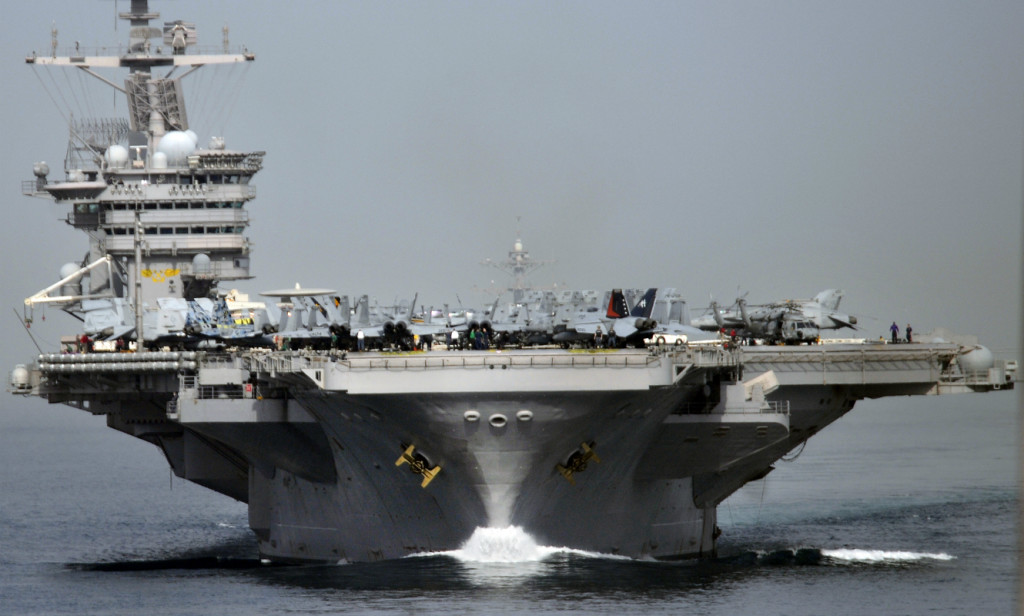The Future of the Carrier Air Wing Looks Dim

Two problems emerge in the history of superpowers. First, it takes a significant investment in military infrastructure to stay on top. Second, they present a large target for rising nations intent on claiming the top step on the podium. The size of the investment in military hardware inclines superpowers towards stability in their force structure: Persians liked chariots, Romans liked legions, Napoleon liked artillery, and Americans like aircraft carriers. However, this kind of stability makes for easy calculations by rising powers. Chariots, legions, and artillery were each overcome by competitors. Today, even the carrier is finding competition in the strategic environment from long-range missiles. However, the challenge to the carrier comes not just from external powers but also from internal mistakes.
The end of the Cold War brought about a period of rapid reevaluation of the strategic environment. The assumptions that had been the bedrock of the U.S.–Soviet Union confrontation — non-permissive environments and contested supremacy — gave way to their opposites. American preponderance was assumed, and access to the global commons at sea, in the air, and in space was assured. Given the new security environment, radical changes were made within the national defense portfolio that had significant implications with regard to positioning and operating naval forces. Range and the deep strike mission were allowed to atrophy as carriers moved closer to shore and their land-based targets. Short-range, light attack aircraft replaced older, long-range aircraft as time passed, and the carrier itself became optimized, at great cost, to launch increasing numbers of aircraft each day — even as the overall size of the carrier air wing decreased due to the rising price of individual airplanes.
These assumptions held, but only for a while. By the mid-1990s other nations, led by China, noted the methods by which the United States waged war and began to develop weapons systems aimed at pushing Americans back and denying them access to the global commons. These anti-access/area-denial weapons — an interconnected series of sensors, aircraft, ships, and missiles — seek to take advantage of the United States’ decision to cede range and deep strike and push American ships and aircraft back beyond their operating ranges. In this way they protect their leaders from U.S. power projection and regime change strategies that have dominated modern American wars. These investments by China, Russia, Iran, and North Korea effectively negate American post-Cold War assumptions and re-impose the non-permissive environments and contested commons that have characterized most of human history.
To assure its continued role as a strong guiding power within the global international system of governance that it has labored to build over the past 70 years, the United States in general, and the Navy in particular, will need to reinvest and “buy back” range for its carrier air wings in order to present a credible deep strike capability to its competitors. The air wing must regain the ability to operate comfortably beyond 1,000 nautical miles from the carrier, much as it did from the mid-1950s to the mid-1990s. Also, an emphasis must be placed on growing the carrier air wing from its present complement of 60-plus aircraft to its historic average of 80-plus planes per air wing. Mass provides the carrier air wing with the ability to range far and wide in search of targets, and then to combine with overwhelming numbers at the moment of attack: Range and mass have characterized the carrier air wing since its inception in the early 1920s for a reason. The present era can only be viewed as an aberration and rejection of the lessons learned from the fleet problems of the 1930s, in the Pacific theater of the Second World War, and during the Cold War. The ability to project power against vital political and economic centers from long range to end wars quickly has been, and must remain, the strategic focus of the nation and its Navy.
Today the combination of the F/A-18E/F Super Hornets and the F-35C Lightning II Joint Strike Fighter represents the immediate future of the carrier air wing, which will be comprised of two squadrons (24 aircraft) of Super Hornets and two squadrons (20 aircraft) of Joint Strike Fighters — along with accompanying E-2D Hawkeyes, EA-18G Growlers, CV-22 carrier onboard delivery aircraft, and helicopters, for a 62-aircraft air wing. Taken together they have an average un-refueled range of just under 500 nautical miles, a far cry from the 1,200-nautical mile average range of the 1950s. The current air wing also lacks a substantial organic tanking capability. Such an air wing is not capable of upholding the nation’s interests in the face of rising competitors.
However, options exist that include truncating or canceling the acquisition of the Joint Strike Fighter, extending the production of the venerable and effective Super Hornet, and accelerating the development and introduction of a viable unmanned combat aerial vehicle capable of spanning the vast distances imposed by anti-access/area-denial systems. The U.S. government should aggressively investigate these options and select a viable path forward. Today’s carriers and their accompanying air wings, with their shrinking ability to project mass power at great distance, represent 25 years of actively forgetting critical historical lessons. History, like the enemy, does not forgive.
Dr. Jerry Hendrix is a senior fellow and director of the Defense Strategies and Assessments Program at the Center for a New American Security. He is a retired Navy captain and a career naval flight officer.
Photo credit: Official U.S. Navy Imagery

